Review: AMERICAN BALLET THEATRE SCORES SPLENDIDLY WITH ABT FORWARD at Segerstrom Center For The Arts
This pristine presentation consists of three different and unique pieces using music from America's most distinguished contemporary Composers with Choreographers to match.

March 16-19, 2022
The "American" in American Ballet Theatre is more evident than ever before. The pristine presentation consisted of three different and unique pieces using music from America's most distinguished contemporary Composers. Leonard Bernstein, the varied well-known composers and lyricists of songs Tony Bennett sings, and noted jazz pianist Jason Moran; with contemporary, audacious, well-known Choreographers Alexei Ratmansky (ABT's Artist in Residence) the legendary Alonzo King (his first piece for ABT), and the whimsical, all-out entertaining Jessica Lang.
Established in 1940, ABT's standard of excellence has strengthened each year, and remains one of their most enduring qualities. The steady, creative force of ABT's Artistic Director, Kevin Mckenzie has insured it. Uplifting, joyous music and dancing, is just what the doctor ordered after our two-year pandemic onslaught.
Just before curtain, Kevin Mckenzie stepped on stage to heartfeltly announce both ABT and The Segerstrom Center for the Arts were dedicating this performance to the brave people fighting in Ukraine. "We not only stand with the Ukrainians, we'll dance for them."
This first piece premiered digitally on March 23, 2021 during the pandemic.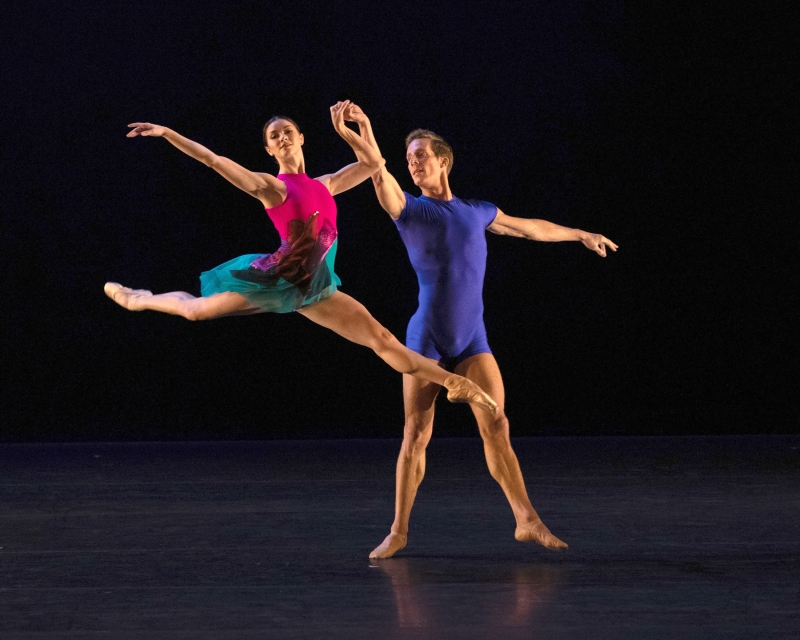
Off to a rousing start, "Bernstein in a Bubble'," choreographed by Alexei Ratmansky, performed live by the Pacific Symphony, and conducted by Charles Baker (which was so glorious, after being gone so long from attending live performances) playing Leonard Bernstein's composition "Divertimento," added brightly clad dancers, a few at a time, dancing little vignettes, short balletic combinations, sometimes as a duet, a solo, trio or in tightly woven groups. The dancers were sharp, precise, clean and energetic with beautiful placement and technique. There were ever-changing positions, groupings, lovely lifts and formations to go with each diverse movement, eight of them, each one a different style, tempo and look. With mostly wind instruments shaping the melodies, it gave a full sound to the Waltz, a Mazurka, a Samba, a March, the Blues, not to mention a Turkey Trot. There were a few violin, piano and harp strains, and a lot of percussion in the last few movements, which afforded the dancers so much musicality to work with.
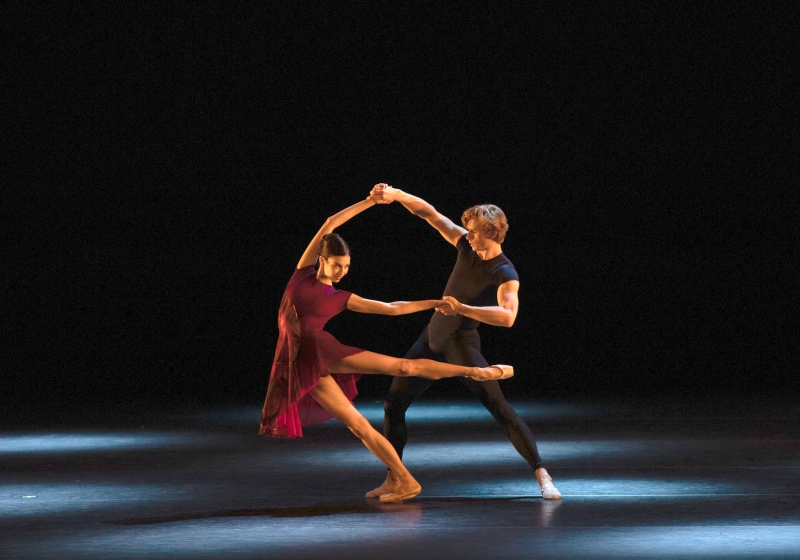 The choreography showed the diversity within the Company, to match the composition itself.
The choreography showed the diversity within the Company, to match the composition itself.
I especially enjoyed the trio of men in royal blue attire, and the blues duet with Chloe Misseldine and Andrii Ishchuk. The full cast performed in this opening, giving it a light, airy and festive feel and was a great beginning. The costuming and color choices made each section pop with blasts of color. Moritz Junge created, Mark Happel constructed and Gene Mignola did the digital fabric painting on the simple but effective costuming. Brad Fields succinct lighting also enhanced the look and feel of the piece.
The second presentation of the evening was the World Premiere of Alonzo King's "Single Eye," a powerful piece that was a feast for the eyes and quite different than the first piece. With more somber tones and more purposeful choreography to illuminate the passage from Matthew 6:22, "If thine eye be single, thy whole body shall be full of light," the dancers had a focus and intention that drove their movements. The energy was palpable and generated out to the audience. The music, composed by jazz pianist Jason Moran, is all-consuming to the senses, and his seven different piano solos that match up to the seven dance sections are mesmerizing, intricate, the choreography drawing you in to a picture of togetherness, compromise, unity, and survival. A sort of group effort to forge ahead, sustain humanity and nurture the environment and us back to health. The added recordings of birds tweeting and other sounds of nature, provided by Bernie Krause, gave a broader sense of urgency and the importance we must adopt to accomplish this.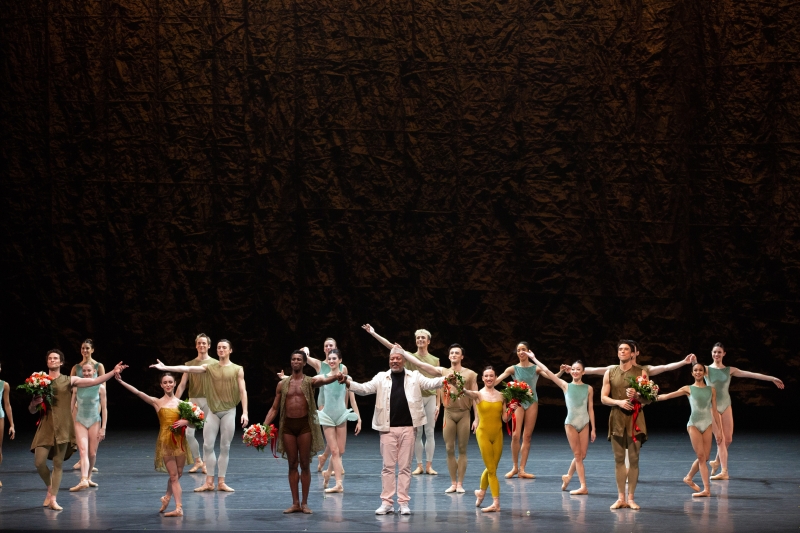
Beginning with a shimmering see-through curtain, nine dancers in soft blue leotards enter behind it, forming a circle, doing fast footwork, as grey smoke fills the air. They join together in a diagonal formation moving across the floor in a most difficult position; walking in deep turned-out second plie en pointe, in unison. Then moving to different accents in the music, swirling constantly, covering the stage, they exit to both sides of the wings.
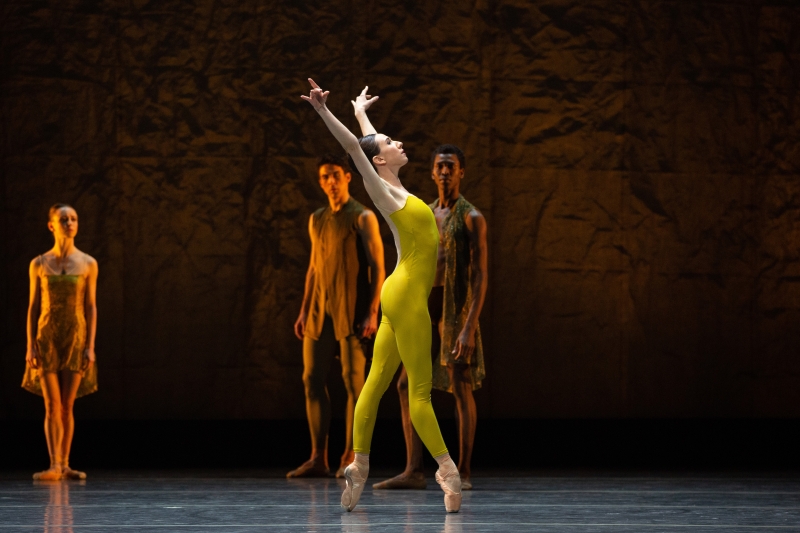 The pas de deux performed by Christine Shevchenko and Cory Sterns is just marvelous. He, assisting her turning in paunche', then as she battements, following up with multiple pirouettes, guiding and lifting her, until we hear discordant sounds that change the mood and tone. Costumed in a stunning golden unitard, she begins to resist him, the energy flowing between them intensifying, becoming a war of wills. She clings onto him from behind, then drags him back using her arm around his neck. He willingly lifts her as she grande jetes across the floor, then she shoves him back belaboredly until they are both offstage.
The pas de deux performed by Christine Shevchenko and Cory Sterns is just marvelous. He, assisting her turning in paunche', then as she battements, following up with multiple pirouettes, guiding and lifting her, until we hear discordant sounds that change the mood and tone. Costumed in a stunning golden unitard, she begins to resist him, the energy flowing between them intensifying, becoming a war of wills. She clings onto him from behind, then drags him back using her arm around his neck. He willingly lifts her as she grande jetes across the floor, then she shoves him back belaboredly until they are both offstage.
A strong, vigorous solo ensues, performed magnificently by Herman Cornejo. He masterfully commands the stage with every movement, grounded, yet bringing strength and agility to the intricate choreography.
There are several scrim changes during this piece that compliment the differences in the separate sections and give a more in-depth sensation. The costumes, as well, compliment each other, each one unique and carrying the see-thru theme sporadically. Set and costume designer Robert Rosenwasser's clever and unique designs are in rich earthy tones of brown, copper and gold, mixing with the powder blue velvet leotards on the ensemble, some having a whimsical fluffed tutu attached at their hips. Lighting by Jim French is coordinated perfectly to highlight movements.
separate sections and give a more in-depth sensation. The costumes, as well, compliment each other, each one unique and carrying the see-thru theme sporadically. Set and costume designer Robert Rosenwasser's clever and unique designs are in rich earthy tones of brown, copper and gold, mixing with the powder blue velvet leotards on the ensemble, some having a whimsical fluffed tutu attached at their hips. Lighting by Jim French is coordinated perfectly to highlight movements.
The next section was melodically intricate, with six dancers, two males and four females dancing at the same time, each following a different strain or melody in varying formations, ending with a short solo by one female dancer with lots of port de bras, seeming to wrap things up by sweeping to the floor and writing something on the stage floor with a flourish, before exiting.
A series of short solos to a very allegro tempo by these same dancers, with four ladies in blue doing some intricate swift footwork together, as one of them leaps forward to solo, very cleanly interpreting each note of the music.
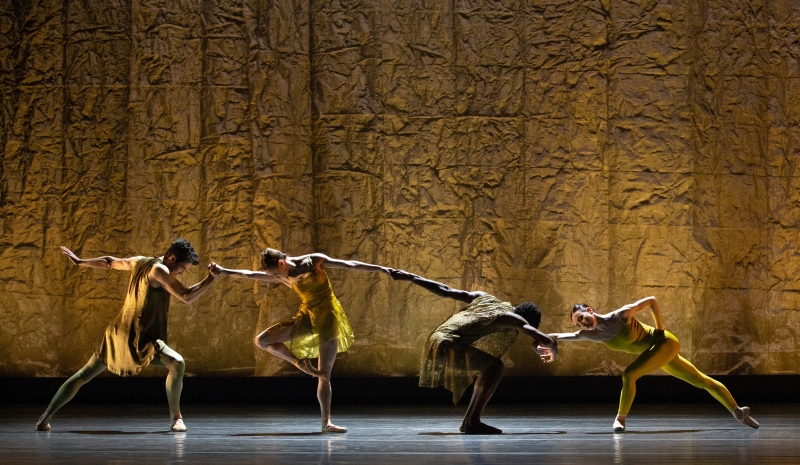 The quartet of principal dancers, on this eve, Christine Shevchenko, Calvin Royal III, Devon Teuscher and Cory Stearns, take the next piano solo, alternating with solos, blending together, each following different melodies and resounding chords as they dance in a line staying attached to each other, and interpretive partnerwork that ritards into slo-mo movements, finally, slowly, all walk off stage, to the pounding of drums.
The quartet of principal dancers, on this eve, Christine Shevchenko, Calvin Royal III, Devon Teuscher and Cory Stearns, take the next piano solo, alternating with solos, blending together, each following different melodies and resounding chords as they dance in a line staying attached to each other, and interpretive partnerwork that ritards into slo-mo movements, finally, slowly, all walk off stage, to the pounding of drums.
An ensemble section is next utilizing the ten ladies in blue to frame and enhance the men doing solos, one at a time, on different sides of the stage, some to no music, with very jazzy steps within the framework of ballet, the melodies just soaring. Particularly effective is Devon Teuscher as she partners and solos with much aplomb.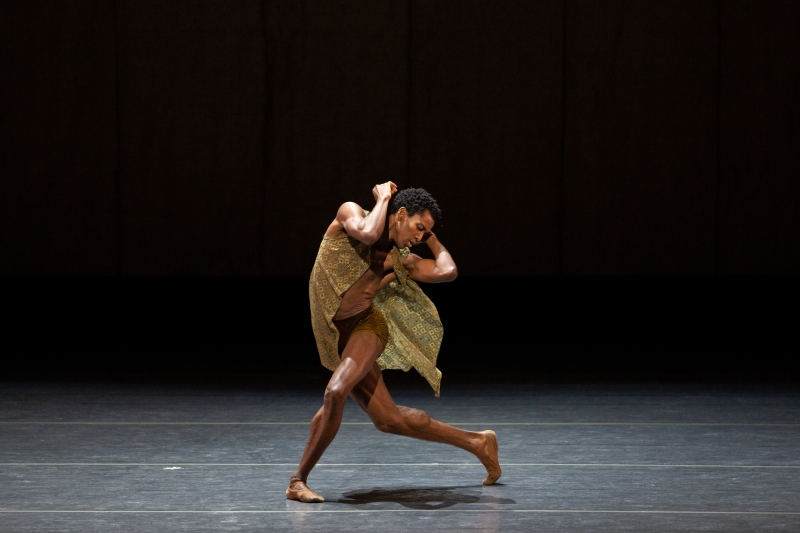
The powerful solo near the end by Calvin Royal III, encapsulates the fervent energy and drive behind the theme. He is mesmerizing to watch and shines as he fully demonstrates the artistry of Alonzo King's choreography.
ZigZag, the final piece, was an exciting and uplifting tribute to Tony Bennett. Hearing him sing so many of the favorites songs he made famous, "I Left My Heart in San Francisco," "Fascinating Rhythm," "Smile," "Just One of Those Things," and several others, was a real treat, all on it's own, but the lighthearted, jazzy choreography and extremely proficient dancers made the lyrics come alive. Also contributing greatly to this festive vibe were the wonderful, vibrant costumes, designed by Wes Gordon, for Caroline Herrera; the spot-on lighting by Nicole Pearce, and the oh, so creative Scenery Design by Derek McLane, utilizing artwork done by Tony Bennett, and a beautiful city skyline on the back scrim. The song "It's De-Lovely" was sung by Lady Gaga and Mr. Bennett, and was as delightful to watch as to hear.
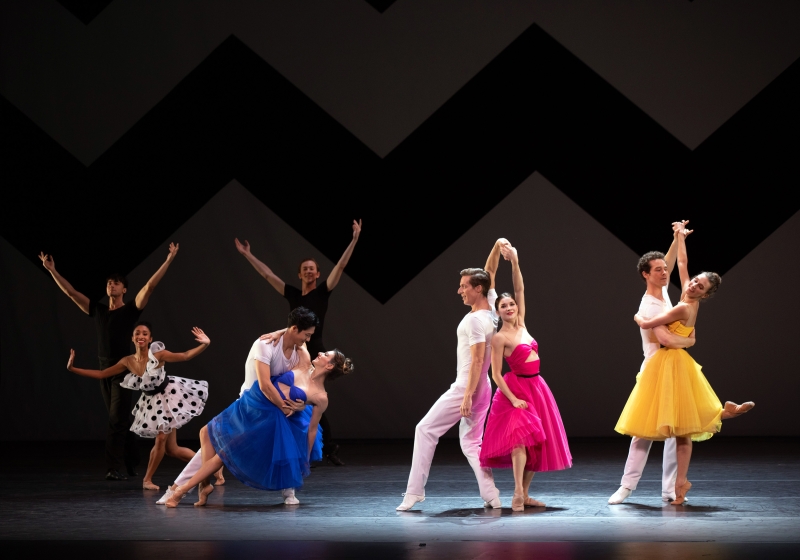 Most of the ladies were not en pointe for this piece (except the trio of bright-colored ladies) and much of the choreography was jazz oriented, including the jitterbug, swing dancing, lots of flexed feet and jazzy movements included in the many lifts and combinations. It was high-spirited, and these remarkably well-trained dancers seem to be able to adapt and conquer any style. There were even some acrobatics and eccentric dancing thrown into the mix, all fitting right into the style of music Tony Bennett was famous for.
Most of the ladies were not en pointe for this piece (except the trio of bright-colored ladies) and much of the choreography was jazz oriented, including the jitterbug, swing dancing, lots of flexed feet and jazzy movements included in the many lifts and combinations. It was high-spirited, and these remarkably well-trained dancers seem to be able to adapt and conquer any style. There were even some acrobatics and eccentric dancing thrown into the mix, all fitting right into the style of music Tony Bennett was famous for.
And polka dots just make you happy. 
Each performer was highlighted during the ten songs, showing the strength and mastery of each, while we also got plenty of pizzazz and sincere enjoyment exuding from them.
It made the night so fulfilling!
American Ballet Theatre is moving forward, splendidly, and it was a night to celebrate Dance.
For more on ABT: https://www.abt.org
Segerstrom Center for the Arts: https://www.scfta.org/
Photos Courtesy of Marty Sohl and Rosalie O'Connor
Reader Reviews

Videos

